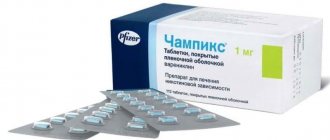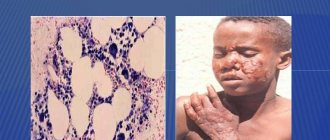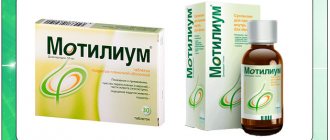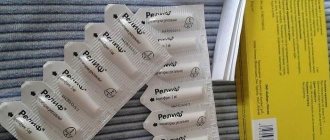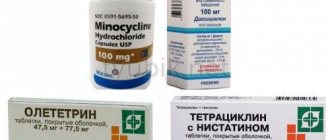Indications for use of Aminazin
Aminazine is indicated for chronic paranoid and hallucinatory-paranoid states, alcoholic psychosis, psychomotor agitation in schizophrenia, manic-depressive psychosis, agitated depression in patients with presenile psychosis, mental disorders in epilepsy and other diseases accompanied by tension and agitation. In addition, Aminazine is used for persistent pain, persistent sleep disorders, neurotic diseases with increased muscle tone, Meniere's disease, itchy dermatoses, as well as for the treatment and prevention of vomiting during radiation therapy and treatment with antitumor drugs.
Drug interactions
- With the simultaneous use of drugs that have a depressant effect on the central nervous system, ethanol-containing drugs, ethanol, it is possible to increase the depressive effect on the central nervous system, as well as respiratory depression.
- When used together with anticonvulsants, the threshold for convulsive readiness may be reduced; with drugs for the treatment of hyperthyroidism - increased risk of developing agranulocytosis; with drugs that cause extrapyramidal reactions - there is a risk of increasing the severity and frequency of extrapyramidal disorders; with drugs that provoke arterial hypotension - an additive effect on blood pressure is possible.
- With the combined use of maprotiline, tricyclic antidepressants, and MAO inhibitors, there is a risk of developing NMS.
- When used together with anticholinergic drugs, the anticholinergic effect may be enhanced; with amphetamines - antagonistic interaction; with anticholinesterase drugs - worsening myasthenia gravis, muscle weakness.
- When used simultaneously with antacids containing magnesium and aluminum hydroxide, the concentration of chlorpromazine in the blood plasma decreases due to impaired absorption from the gastrointestinal tract.
- When combined with oral hormonal contraceptives, a case of increased levels of chlorpromazine in the blood plasma has been described.
- When used together with amitriptyline, the risk of developing tardive dyskinesia increases.
- When used in combination, chlorpromazine may reduce or inhibit the antihypertensive effects of guanethidine.
- When used concomitantly with diazoxide, severe hyperglycemia may occur; with zolpidem - the sedative effect increases; with doxepin - potentiation of hyperpyrexia; with zopiclone - the sedative effect increases; with imipramine - the level of imipramine in the blood plasma increases.
- When administered together with lithium carbonate, pronounced extrapyramidal manifestations and neurotoxic effects are possible; with morphine - myoclonus may develop.
- When used in combination, chlorpromazine suppresses the effects of levodopa as a result of blockade of dopamine receptors in the central nervous system.
- When administered in combination with nortriptyline in patients with schizophrenia, the clinical condition may worsen. Cases of the development of paralytic ileus have been described.
- Convulsions may occur when used concomitantly with piperazine; with propranolol - increased levels of propranolol and chlorpromazine in the blood plasma; with trazodone - arterial hypotension; with trihexyphenidyl – development of paralytic ileus; with trifluoperazine - severe hyperpyrexia; with phenytoin - a decrease or increase in the concentration of phenytoin in the blood plasma.
- With the combined use of cisapride, the QT interval on the ECG is prolonged.
- When co-administered with fluoxetine, the risk of developing extrapyramidal symptoms increases; with sulfadoxine/pyrimethamine, chloroquine, the level of chlorpromazine in the blood plasma increases.
- When administered concomitantly with cimetidine, there is a risk of reducing the concentration of chlorpromazine in the blood plasma.
- When used together with ephedrine, the vasoconstrictor effect of ephedrine may be weakened.
Contraindications
According to the instructions for Aminazine, this drug is contraindicated for:
- progressive systemic diseases of the brain and spinal cord;
- dysfunction of the kidneys, liver or hematopoietic organs;
- severe cardiovascular diseases;
- angle-closure glaucoma;
- thromboembolic disease;
- pronounced depression of the central nervous system;
- late stage of bronchiectasis;
- brain injuries;
- comatose state;
- urinary retention due to prostatic hyperplasia.
Release form and composition
Available in the form of dragees, solution for intravenous and intramuscular administration and tablets.
| Aminazine, dragee | 1 dragee |
| Chlorpromazine hydrochloride | 50 mg |
| Excipients: sucrose (sugar), starch syrup, gelatin, wax, talc, titanium dioxide, sunflower oil, red iron oxide dye. | |
| Solution | 1 ml |
| Chlorpromazine hydrochloride | 25 mg |
| Pills | 1 table |
| Chlorpromazine hydrochloride | 25 mg |
| Excipients: potato starch, microcrystalline cellulose, lactose monohydrate, copovidone, croscarmellose sodium, magnesium stearate. | |
| Film shell composition: Opadry II 85F38209, including partially hydrolyzed polyvinyl alcohol, macrogol-3350, talc, titanium dioxide, yellow iron oxide dye. | |
Side effects of Aminazine
When using Aminazine, the following undesirable effects are possible:
- from the cardiovascular system - tachycardia and arterial hypotension;
- from the central nervous system - blurred vision, akathisia, parkinsonian syndrome, thermoregulation disorders, dystonic extrapyramidal reactions;
- from the hematopoietic system – agranulocytosis, leukopenia;
- from the digestive system – dyspeptic symptoms, cholestatic jaundice;
- from the endocrine system - impotence, menstrual irregularities, weight gain, weight gain;
- from the urinary system – difficulty urinating;
- dermatological reactions – photosensitivity, skin pigmentation;
- allergic reactions - itching, skin rash, erythema multiforme, exfoliative dermatitis;
- on the part of the organ of vision - chlorpromazine may be deposited in the cornea and lens, which, with prolonged use of the drug, can accelerate the aging process of the lens.
Dragee Aminazine
Instructions for medical use of the drug
Description of pharmacological action
Aminazine is one of the main representatives of neuroleptics (medicines that have an inhibitory effect on the central nervous system and do not cause a hypnotic effect in normal doses). Despite the emergence of numerous new antipsychotic drugs, it continues to be widely used in medical practice. One of the main features of the action of aminazine on the central nervous system is its relatively strong sedative effect (calming effect on the central nervous system).
Indications for use
In psychiatric practice, aminazine is used in various states of psychomotor agitation in patients with schizophrenia (hallucinatory-delusional, hebephrenic, catatonic syndromes), in chronic paranoid and hallucinatory-paronoid states, manic agitation in patients with manic-depressive psychosis (psychosis with alternating excitement and depression of mood) , with psychotic disorders in patients with epilepsy, with agitated depression (motor excitation against a background of anxiety and fear) in patients with presenile (stressful), manic-depressive psychosis, as well as with other mental illnesses and neuroses accompanied by agitation, fear, insomnia, tension, in acute alcoholic psychosis. Aminazine can be used either alone or in combination with other psychotropic drugs (antidepressants, butyrophenone derivatives, etc.). A peculiarity of the action of aminazine in states of excitement in comparison with other antipsychotics (triftazine, haloperidol, etc.) is a pronounced sedative (calming) effect. In neurological practice, aminazine is also prescribed for diseases accompanied by increased muscle tone (after a cerebral stroke, etc.). Sometimes used to relieve status epilepticus (if other treatment methods are ineffective). It is administered intravenously or intramuscularly for this purpose. It should be borne in mind that in patients with epilepsy, chlorpromazine can cause an increase in seizures, but usually when prescribed simultaneously with anticonvulsants, it enhances the effect of the latter. The use of aminazine in combination with analgesics for persistent pain, including causalgia (intense burning pain due to damage to a peripheral nerve), and with sleeping pills and tranquilizers (sedatives) for persistent insomnia is effective. Aminazine is sometimes used as an antiemetic agent for vomiting of pregnant women, Meniere's disease (a disease of the inner ear), in oncological practice - in the treatment of bis-(beta-chloroethyl)amine derivatives and other chemotherapeutic drugs, and during radiation therapy. In the clinic of skin diseases for itchy dermatoses (skin diseases) and other diseases.
Release form
dragee 25 mg; contour packaging 10, cardboard pack 3,5,10. dragee 50 mg; contour packaging 10, cardboard pack 3,5,10. dragee 100 mg; contour packaging 10, cardboard pack 3,5,10. dragee 25 mg; contour cellular packaging 10. tablets 50 mg; contour cellular packaging 10. tablets 100 mg; contour cellular packaging 10. tablets 25 mg; polymer jar (jar) 3200. dragee 50 mg; polymer jar (jar) 2285. dragee 100 mg; polymer jar (jar) 1600.
Pharmacodynamics
Antipsychotic drug (neuroleptic) from the group of phenothiazine derivatives. It has a pronounced antipsychotic, sedative, antiemetic effect. Reduces or completely eliminates delusions and hallucinations, stops psychomotor agitation, reduces affective reactions, anxiety, restlessness, and reduces motor activity. The mechanism of antipsychotic action is associated with blockade of postsynaptic dopaminergic receptors in the mesolimbic structures of the brain. It also has a blocking effect on α-adrenergic receptors and suppresses the release of pituitary and hypothalamic hormones. However, blockade of dopamine receptors increases the secretion of prolactin by the pituitary gland. The central antiemetic effect is due to inhibition or blockade of dopamine D2 receptors in the chemoreceptor trigger zone of the cerebellum, the peripheral effect is due to blockade of the vagus nerve in the gastrointestinal tract. The antiemetic effect is enhanced, apparently, due to anticholinergic, sedative and antihistamine properties. The sedative effect is apparently due to alpha-adrenergic blocking activity. Has moderate or weak extrapyramidal effects.
Pharmacokinetics
When taken orally, chlorpromazine is rapidly, but sometimes not completely, absorbed from the gastrointestinal tract. Cmax in blood plasma is reached after 2-4 hours. It is subject to the “first pass” effect through the liver. Due to this effect, plasma concentrations after oral administration are less than concentrations after intramuscular administration. Intensively metabolized in the liver with the formation of a number of active and inactive metabolites. The metabolic pathways of chlorpromazine include hydroxylation, conjugation with glucuronic acid, N-oxidation, oxidation of sulfur atoms, dealkylation. Chlorpromazine has high binding to plasma proteins (95-98%). It is widely distributed in the body, penetrates the BBB, and the concentration in the brain is higher than in plasma. There was marked variability in pharmacokinetic parameters in the same patient. There is no direct correlation between plasma concentrations of chlorpromazine and its metabolites and the therapeutic effect. T1/2 of chlorpromazine is about 30 hours; It is believed that the elimination of its metabolites may take longer. Excreted in urine and bile in the form of metabolites.
Use during pregnancy
If it is necessary to use chlorpromazine during pregnancy, the duration of treatment should be limited, and at the end of pregnancy, if possible, the dose should be reduced. It should be borne in mind that chlorpromazine prolongs labor. If use is necessary during lactation, breastfeeding should be discontinued. Chlorpromazine and its metabolites penetrate the placental barrier and are excreted in breast milk. Clinical studies have shown that chlorpromazine may have a teratogenic effect. When chlorpromazine was used in high doses during pregnancy in newborns, in some cases, digestive disorders associated with atropine-like effects and extrapyramidal syndrome were observed.
Contraindications for use
Impaired function of the liver, kidneys, hematopoietic organs, progressive systemic diseases of the brain and spinal cord, myxedema, severe cardiovascular diseases, thromboembolic disease; late stage of bronchiectasis; angle-closure glaucoma; urinary retention associated with prostatic hyperplasia; severe depression of the central nervous system, coma, brain injury.
Side effects
From the side of the central nervous system: possible akathisia, blurred vision; rarely - dystonic extrapyramidal reactions, parkinsonian syndrome, tardive dyskinesia, thermoregulation disorders, NMS; in isolated cases - convulsions. From the cardiovascular system: possible arterial hypotension (especially with intravenous administration), tachycardia. From the digestive system: dyspeptic symptoms are possible (when taken orally); rarely - cholestatic jaundice. From the hematopoietic system: rarely - leukopenia, agranulocytosis. From the urinary system: rarely - difficulty urinating. From the endocrine system: menstrual irregularities, impotence, gynecomastia, weight gain. Allergic reactions: possible skin rash, itching; rarely - exfoliative dermatitis, erythema multiforme. Dermatological reactions: rarely - skin pigmentation, photosensitivity. On the part of the organ of vision: with long-term use in high doses, chlorpromazine may be deposited in the anterior structures of the eye (cornea and lens), which can accelerate the processes of normal aging of the lens.
Directions for use and doses
Installed individually. When taken orally for adults, the single dose is 10-100 mg, the daily dose is 25-600 mg; for children aged 1-5 years - 500 mcg/kg every 4-6 hours; for children over 5 years old, 1/3-1/2 adult doses can be used. When administered intramuscularly or intravenously for adults, the initial dose is 25-50 mg. When administered intramuscularly or intravenously in children over 1 year of age, the single dose is 250-500 mcg/kg. The frequency of oral or parenteral use depends on the indications and clinical situation. Maximum single doses: for adults when taken orally - 300 mg, when administered intramuscularly - 150 mg, when administered intravenously - 100 mg. Maximum daily doses: for adults when taken orally - 1.5 g, when administered intramuscularly - 1 g, when administered intravenously - 250 mg; for children under 5 years of age (body weight up to 23 kg) when taken orally, intramuscularly or intravenously - 40 mg, for children over 5 years of age (body weight over 23 kg) when taken orally, intravenously m or intravenous administration - 75 mg.
Special instructions for use
Phenothiazines are used with extreme caution in patients with pathological changes in the blood picture, liver dysfunction, alcohol intoxication, Reye's syndrome, as well as breast cancer, cardiovascular diseases, predisposition to the development of glaucoma, Parkinson's disease, gastric and duodenal ulcers , urinary retention, chronic respiratory diseases (especially in children), epileptic seizures. Phenothiazines should be used with caution in elderly patients (increased risk of excessive sedation and hypotensive effects), in debilitated and weakened patients. If hyperthermia occurs, which is one of the symptoms of NMS, chlorpromazine should be discontinued immediately. Children, especially those with acute illness, are more likely to develop extrapyramidal symptoms when using phenothiazines. During the treatment period, avoid drinking alcohol. Effect on the ability to drive vehicles and operate machinery Should be used with caution in patients engaged in potentially hazardous activities that require a high speed of psychomotor reactions.
Storage conditions
In a place protected from light, at a temperature of 15–25 °C.
Best before date
24 months
ATX classification:
N Nervous system
N05 Psycholeptics
N05A Antipsychotic drugs
N05AA Phenothiazine derivatives with aliphatic structure
N05AA01 Chlorpromazine
special instructions
The drug Aminosin should be used with extreme caution in patients with impaired liver function, pathological changes in the blood picture, alcohol intoxication, breast cancer, Reye's syndrome, Parkinson's disease, cardiovascular diseases, a predisposition to the development of glaucoma, and chronic respiratory diseases.
If signs of hyperermia appear, the drug should be discontinued immediately.
During the treatment period it is unacceptable to drink alcohol.
In elderly, as well as weakened and depleted patients, Aminazine is used with caution, as the risk of excessive hypotensive and sedative effects is increased.
Aminazine may affect the patient's ability to perform activities that require a high speed of psychomotor reactions.
Similar drugs:
- Ergoferon () Lozenges
- Celandine grass (Chelidonii majoris herba) Vegetable raw materials
- L-cet Oral tablets
- Loratadine Syrup
- Peritol Oral tablets
- Loratadine-Teva Oral tablets
- Erespal Oral tablets
- Levocetirizine-Teva Oral tablets
- Lordestin Oral tablets
- Zyrtec Oral drops
** The Drug Directory is intended for informational purposes only. For more complete information, please refer to the manufacturer's instructions. Do not self-medicate; Before starting to use the drug Aminazine, you should consult a doctor. EUROLAB is not responsible for the consequences caused by the use of information posted on the portal. Any information on the site does not replace medical advice and cannot serve as a guarantee of the positive effect of the drug.
Are you interested in the drug Aminazine? Do you want to know more detailed information or do you need a doctor's examination? Or do you need an inspection? You can make an appointment with a doctor - the Euro lab is always at your service! The best doctors will examine you, advise you, provide the necessary assistance and make a diagnosis. You can also call a doctor at home . Euro lab clinic is open for you around the clock.
** Attention! The information presented in this medication guide is intended for medical professionals and should not be used as a basis for self-medication. The description of the drug Aminazine is provided for informational purposes and is not intended for prescribing treatment without the participation of a doctor. Patients need to consult a specialist!
If you are interested in any other drugs and medications, their descriptions and instructions for use, information about the composition and form of release, indications for use and side effects, methods of use, prices and reviews of drugs, or you have any other questions and suggestions - write to us, we will definitely try to help you.
Aminazine price, where to buy
A package of 10 ampoules of 2 ml 25 mg/ml costs approximately 60 rubles.
10 tablets of 25 mg cost about 150 rubles.
The price of Aminazin in tablets is approximately 70 rubles per package of 10 pieces of 100 mg.
- Online pharmacies in RussiaRussia
- Online pharmacies in UkraineUkraine
- Online pharmacies in KazakhstanKazakhstan
ZdravCity
- Aminazine tablets p.p.o. 100 mg 10 pcs. JSC Valenta Pharmaceuticals
Pharmacy Dialogue
- Aminazine (tab.p.pl/vol. 25 mg No. 10) Valenta Pharmaceuticals OJSC
- Aminazine (tab.p.pl/vol. 50 mg No. 10) Valenta Pharmaceuticals OJSC
show more
Pharmacy24
- Aminazine 2.5% 2 ml N10 injection solution PAT "Galichfarm", Ukraine
PaniPharmacy
- Aminazine ampoule Aminazine solution d/in. 2.5% amp. 2ml No. 10 Ukraine, Galichfarm JSC
- Aminazine tablet. p/o 0.1g No. 10 in pack.
- Aminazine ampoule Aminazine solution d/in. 2.5% amp. 2ml No. 10 Ukraine, Health of the people LLC
- Aminazine tablets Aminazine tablets. p/o 0.025g No. 20 Ukraine, Health LLC
- Aminazine tablets Aminazine tablets. p/o 0.1g No. 10 Ukraine, Health LLC
show more
Reviews about Aminazine
Patients recommend keeping Aminazine in your home medicine cabinet, since, thanks to its diverse therapeutic effects, it can be used both to reduce highly elevated blood pressure and relieve muscle hypertonicity, and as a sedative for psychomotor agitation. In addition, the drug is effective in calming prolonged hiccups and as an antiemetic, it can be useful when recovering from withdrawal states.
In most reviews of Aminazine, patients emphasize its high effectiveness and good tolerability, provided that all doctor’s recommendations on the dosage regimen are followed. The moderate cost of the drug is also considered an indisputable advantage.
Features of treatment with Aminazine for various categories
Pregnant
If there is a need to treat a pregnant woman with this drug, then it is recommended to limit the duration of therapy. At the final stage of gestation, the dosage of the drug is reduced, since the active substance Aminazine prolongs the birth process.
Breastfeeding should not be done during treatment due to the excretion of the drug in mother's milk.
The teratogenic effect of Aminazine was noted, due to which extrapyramidal disorders, as well as in the digestive system, could be detected in newborn infants.
For children
Use the drug only as prescribed by a doctor. The development of extrapyramidal symptoms is likely in patients of this age group.
Instructions for use
An antipsychotic that cannot be used without a doctor's prescription is chlorpromazine. The instructions for use of this drug strictly prohibit taking the medication on your own. Leaving such a product unattended is very dangerous. If help is not provided in time, poisoning with the substance can cause death within 10-12 hours.
Aminazine has been used as a therapeutic agent for more than 50 years. The instructions will help to avoid adverse consequences. Despite the emergence of new drugs in this group, it is the most effective and harmless for use in an outpatient setting. The drug is available in tablet form; you can also purchase chlorpromazine in ampoules.
- Tablets are used in the first days of treatment, 25-100 milligrams (1-4 times a day). Then, twice a week, the dosage is increased by 25-50 milligrams until the desired effect is obtained. If there is increased anxiety before surgery, the medicine is prescribed 2-3 hours before surgery. The maximum dose per day should not exceed 1.5 g.
- Aminazine injections are made using a solution of 2.5% concentration. It is administered both intramuscularly and intravenously. For intramuscular injections, the drug is diluted with procaine (0.25-0.5%) or saline solution. Before surgery, an intramuscular injection of aminazine is used at a dose of 5.5 mg per 10 kg of body weight 2 hours before surgery. The maximum daily dose should not exceed 1 g.
Overdose
Symptoms of chlorpromazine overdose may include: areflexia/hyperreflexia, impaired visual perception, dry mouth, mydriasis, hyperpyrexia (hypothermia), vomiting, muscle rigidity, respiratory depression, pulmonary edema. Cardiotoxic effects - heart failure, arrhythmia, drop in blood pressure, change in QRS wave, shock, tachycardia, ventricular fibrillation, cardiac arrest. Neurotoxic effects - agitation, convulsions, confusion, disorientation, drowsiness, stupor or coma.
If you take high doses of Aminazine orally, you should perform a gastric lavage and take activated charcoal. It is necessary to avoid induction of vomiting, since due to overdose disturbances of consciousness and dystonic reactions from the muscles of the neck and head, aspiration of vomit is possible.
Further (in case of parenteral overdose - immediately), symptomatic therapy is recommended:
- collaptoid state: parenteral administration of caffeine, cordiamine, mezatone;
- depression of the central nervous system without suppression of the function of the respiratory center: parenteral administration in moderate doses of pervitin, phenamine, caffeine-sodium benzoate (patients with depression of the respiratory center are contraindicated to use analeptics);
- neurological complications: reduction in the dose of chlorpromazine, use of trihexyphenidyl;
- neuroleptic depression: use of antidepressants and psychostimulants;
- arrhythmias: intravenous administration of phenytoin at a dose of 9–11 mg/kg;
- heart failure: cardiac glycosides;
- pronounced decrease in blood pressure: administration of intravenous fluids or vasopressor drugs (norepinephrine, phenylephrine). The use of α- and β-adrenergic agonists, for example, epinephrine, should be avoided, as this can lead to a paradoxical decrease in blood pressure due to the blockade of α-adrenergic receptors by chlorpromazine;
- convulsions: diazepam. The use of barbiturates should be avoided as it may lead to subsequent CNS depression and respiratory depression;
- parkinsonism: use of diphenyltropine, diphenhydramine;
- hyperthermia, which is one of the symptoms of NMS: parenteral administration of dantrolene.
In addition, for at least five days it is required to monitor the activity of the central nervous system, cardiovascular system, respiratory function, measure body temperature, and it is also recommended to seek advice from a psychiatrist. Dialysis to remove chlorpromazine is ineffective.
Use during pregnancy and lactation
Chlorpromazine passes through the placental barrier, is excreted in breast milk during lactation, and prolongs labor. Experiments on animals revealed that chlorpromazine can cause developmental pathologies in the embryofetal period. There is evidence of a potential risk of extrapyramidal disorders and withdrawal syndrome in newborns whose mothers took Aminazine during the third trimester of pregnancy. Due to the use of high doses of chlorpromazine during pregnancy, in some cases, newborns experienced digestive disorders that are associated with the atropine-like effect of the drug.
In connection with the above, it is contraindicated to prescribe Aminazine during pregnancy. Breastfeeding should be discontinued during treatment.
General symptoms of drug poisoning
The lethal dose for Aminazine poisoning is 5 g. There are known cases of death from 0.5 grams of the drug and recovery after taking 6 or more grams of the drug. The child's body is more sensitive to psychotropic drugs of the neuroleptic series. For them, a lethal dose can be 0.25 grams of the drug or even less.
The pathogenesis of poisoning is a disruption of the nervous system. Loss of consciousness is caused by inhibition of the cerebral cortex, inhibition of reflex conductivity.
Symptoms of acute poisoning with Aminazine:
- severe drowsiness and extreme weakness;
- dizziness;
- ataxia;
- anorexia;
- absence of bowel movements;
- nausea (manifested as a result of severe irritation of the mucous membrane in the stomach);
- a sharp increase in heart rate (sometimes it can be thread-like, that is, difficult to detect);
- drop in blood pressure (sometimes patients experience so-called orthostatic collapse);
- severe allergic reactions (in some cases they can lead to swelling of the larynx and breathing problems);
- urinary retention (it leads to progressive poisoning of the body with decay products).
In case of severe poisoning, loss of consciousness occurs very early, breathing changes according to the Cheyne-Stokes type. The skin becomes pale, almost dry. Hyperreflexia appears against the background of further clouding of consciousness. Severe and prolonged tonic or clonic convulsions occur. Such phenomena tend to repeat themselves.
- Orthostatic type collapse.
- Liver dystrophy.
- Acute liver failure.
- Acute kidney failure.
- Brain swelling.
- Pulmonary edema.
- Acute inflammation of the lung tissue.
- Acute allergic reactions.

